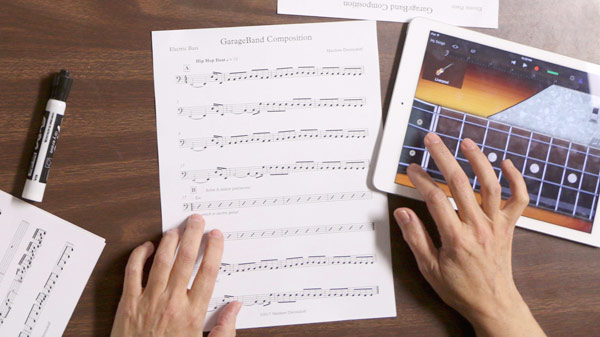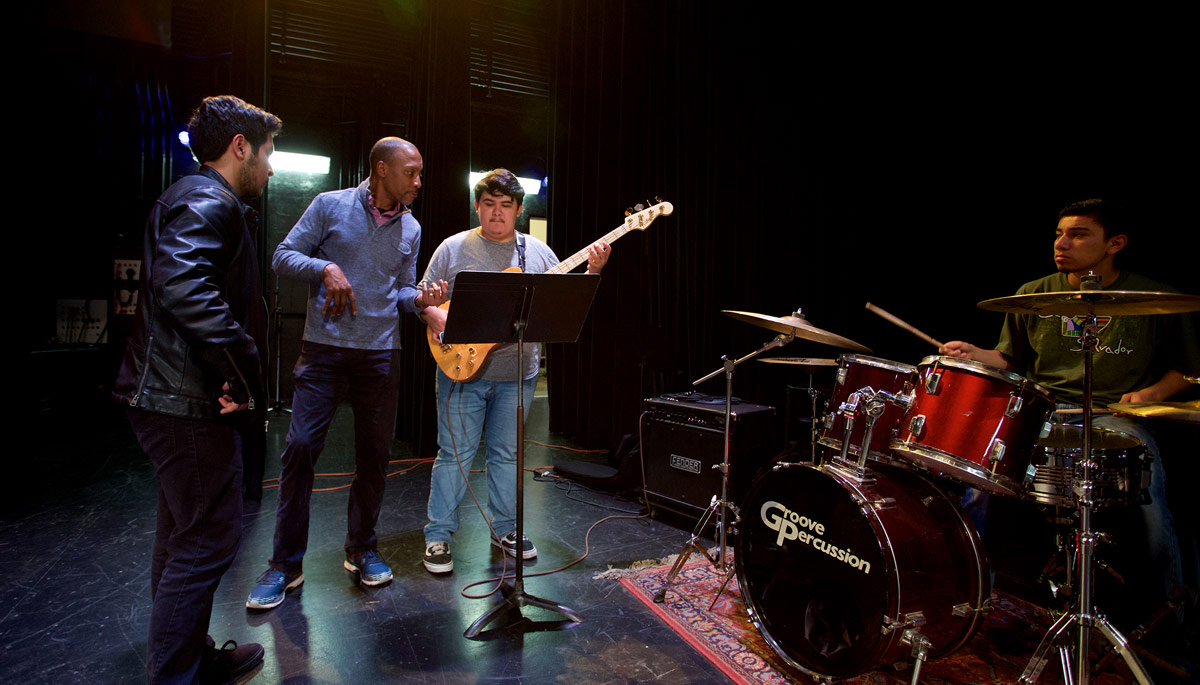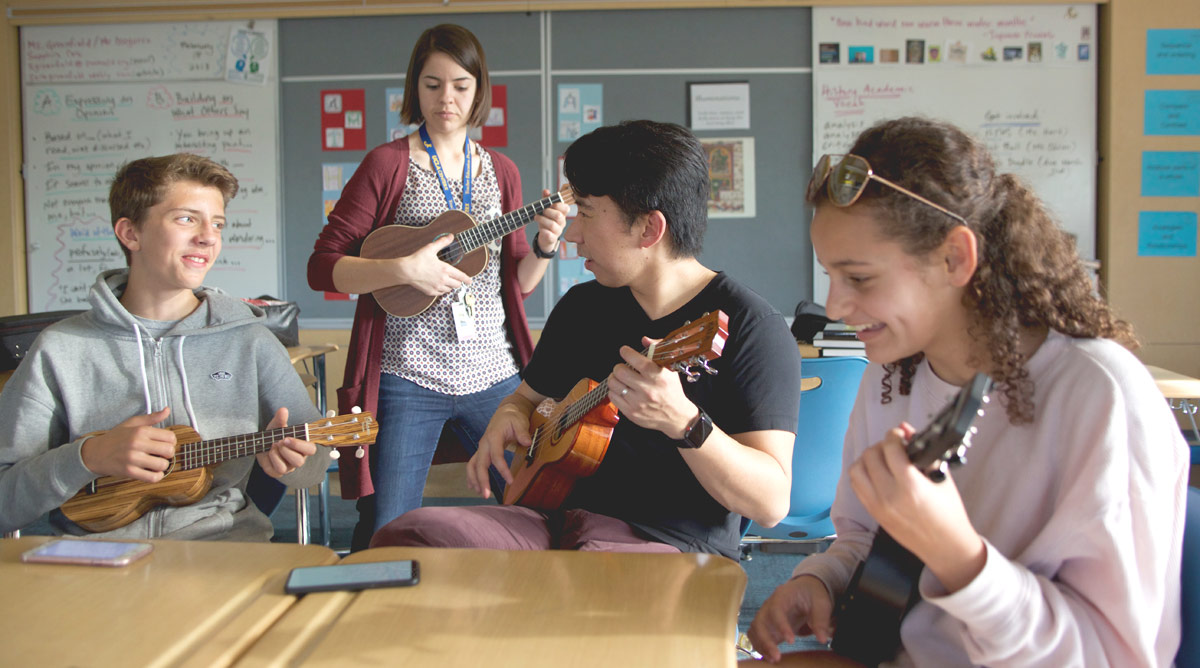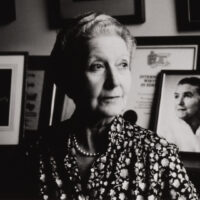
Open Ears, Open Minds
By Evan Calbi

The classrooms that music teachers will step into look differently than they did 10 years ago. The way they are trained should look different as well.
Today’s music educators face exciting and challenging times as students become more diverse, embrace a wider variety of musical styles, and engage with music in their own sophisticated ways. A master’s degree in Music Teaching and Learning offers a new vision of music education in step with this dynamic new landscape.
How to teach music educators
“The core of my teaching philosophy is that my role is not to teach,” said Judy Lewis, who teaches in the K-12 Contemporary Teaching Practice program. “My role is to create situations where students can explore new visions of what music is, new processes of how it’s done, and new ideas of what it looks like when we do it together.”
Case in point: Students in the Music Teaching and Learning program are taught from within a given genre. Want to understand the dynamics of a rock band? Your assignment is to form one and practice in a garage-like setting each week. Want to understand how hip hop works? Your assignment is to produce your own track using one of the free music apps readily available.
This philosophy was at the core of USC Thornton’s launch of the now-celebrated Popular Music program 10 years ago, and it’s at the core of the fundamental rethinking of how to train today’s music educators.
“The idea of just adding popular music repertoire to our existing paradigms of music education misses the point,” Lewis says. “In that case it just becomes an add and stir proposition.”
Here, then, are three examples of recent projects from students that showcase this philosophy in action.
Digital compositions
ASSIGNMENT: Use a combination of prerecorded loops and live parts recorded in a digital music app and add original rap lyrics. Check out Brian Rodriguez’ Garage Band Rap >>
[iframe width=”100%” height=”110″ scrolling=”no” frameborder=”no” allow=”autoplay” src=”https://w.soundcloud.com/player/?url=https%3A//api.soundcloud.com/tracks/512497188%3Fsecret_token%3Ds-dvrO4&color=%23ff5500&auto_play=false&hide_related=true&show_comments=false&show_user=true&show_reposts=false&show_teaser=false”]
As part of the course “Improvisation and Composition,” the students explored dozens of currently available music apps and then produced their own hip hop track.
“It’s important to me to spend a lot of time on digital creativity because I think in large part we’re playing catch-up with what children and youth are already doing,” Lewis says.
There are so many music apps and digital platforms currently available to young musicians, and what was once thought as something students did outside of the music classroom is increasingly being absorbed into the curriculum. The use of digital platforms also allows specific cultures to find a music that speaks to them.
“It’s important that we recognize the tremendous amount of cultural capital that our students have that grows out of their unique socio-cultural landscapes and to start making those connections,” Lewis adds.

USC Thornton alumnus Vince Womack (center) demonstrates bass technique for his students at the James Foshay Learning Center in South Los Angeles. (Photo by Dario Griffin/USC)
Learning by doing
The coursework also includes songwriting assignments where students from every background of music must understand the songwriting process by writing their own song, some for the first time.
ASSIGNMENT: Use one acoustic instrument and vocals and perform live in class. Josh Kim took the text from a poem by Robert Frost >>
[iframe width=”100%” height=”110″ scrolling=”no” frameborder=”no” allow=”autoplay” src=”https://w.soundcloud.com/player/?url=https%3A//api.soundcloud.com/tracks/512497215%3Fsecret_token%3Ds-M5OcX&color=%23ff5500&auto_play=false&hide_related=true&show_comments=false&show_user=true&show_reposts=false&show_teaser=false”]
Form a band, practice like you’re in a garage
This concept of inclusivity can be found across the program where, for example, traditional repertoire for concert band is taught with the same level of interest as a traditional rock band.
And what better way to understand the creative process of a band than by forming one? As part of the course “Pedagogy for Small Ensembles,” students rehearse outside of class each week in an informal ensemble. They may not go into actual garages to practice, but the intent is there.
“The idea is for the students to become familiar with styles of popular music and learning informal processes that are authentic,” Lewis says, “They also learn composition processes that are communal as opposed to classical music where a composer sits alone in a studio writing a composition for musicians to perform.”
ASSIGNMENT: Groups of students exploring arranging and composing in “garage bands” throughout the semester. Listen to a song by Nick Belcher, Eunice Kim, Ryan Williams, and Chris Sullivan >>
[iframe width=”100%” height=”110″ scrolling=”no” frameborder=”no” allow=”autoplay” src=”https://w.soundcloud.com/player/?url=https%3A//api.soundcloud.com/tracks/512497197%3Fsecret_token%3Ds-w16eH&color=%23ff5500&auto_play=false&hide_related=true&show_comments=false&show_user=true&show_reposts=false&show_teaser=false”]
Another aspect of the group assignments is to require students to often play on secondary instruments. A student who earned an undergraduate degree in flute performance, for instance, will play electric bass in her newly formed “garage band.” Yet another assignment asks students to arrange a current pop song with their primary instruments.
“We had a pop arrangement with a bassoon, a flute, and a classical guitar,” says Lewis. “Instead of looking at popular music as a self-contained genre, the idea is to explore how it can stretch the very notion of what an authentic presentation might sound like.”
In other words, these assignments encourage open ears and, through them, open minds.

USC Thornton alumnus and faculty member Jim Wang (center) leads a ukulele lesson at Lincoln Middle School in Santa Monica. (Photo by Dario Griffin/USC)
Transforming the landscape
Young students are as passionate about music as ever, but their interests are wide and varied. Music teachers today need to engage students in creative music projects that span genres, incorporate accessible technology, and encourage learning outside of the classroom.
The goal is simple: The radical thinking experiences in the Music Teaching and Learning degrees seeks to train music teachers to feel comfortable teaching a wind ensemble, overseeing a rock band, or leading a songwriting class using acoustic and digital technology.
“We see no reason why this cannot be a comprehensive goal for music teachers,” says Peter Webster, the vice dean of the division of Scholarly and Professional Studies at USC Thornton. “In short, we are looking to transform the landscape of music teaching and learning to a more contemporary place that celebrates the musical world students inhabit today.”

